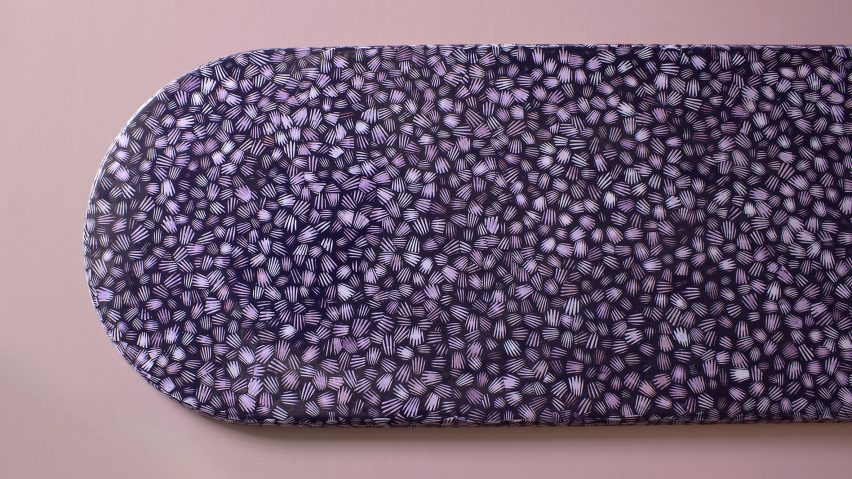British designer Bethan Gray has teamed up with natural surface specialist Nature Squared to create a collection of iridescent furniture clad in leftover materials from the seafood and farming industries.
On show at Spazio Rossana Orlandi during this year's Milan design week, the Exploring Eden furniture collection comprises a shelving unit, lounge chairs, stools and tables made from by-products such as feathers and shells that would otherwise be thrown away.
Gray took advantage of the pearlescent and iridescent qualities of capiz, pearl, scallop and pen shells to give each of the furniture pieces a unique pattern and colour.
Nature Squared, which has an office in the same west London building as Gray, buys the shells directly from workers in Filipino fishing communities, who collect the seafood, tin it and would then otherwise throw the shells away.
"Bethan's design practice has always been around natural materials, graphic pattern and colour," said Owen Goldser, a designer at Gray's studio.
The two studios met at a shared sink in their building, Goldser said. "As the conversation moved along we realised there was an incredible amount of joint thinking."
Nature Squared employs 250 craftspeople in the Philippines, who turn the raw shells into luxury surface materials that are usually used for the interiors of super yachts and private jets.
"Creating objects of outstanding beauty and quality is absolutely at the core of ensuring that the materials we work with are recognised and cherished," said Nature Squared co-founder Lay Koon Tan.
"The more we find a market for what we produce, the more we create a virtuous circle of jobs, appreciation for materials that are currently seen as waste, acceptance of sustainable practices, and self-belief in our people," she continued.
Nature Squared handmade fine shell-threads from leftover mother-of-pearl taken from river-pearl cultivation that were used to create a series of cylindrical, fluted stools and side tables.
Each thread is ground down to the desired smoothness and fineness before being inlaid into the base material, and the gaps filled in with a black resin.
Further pieces include a table with etch-like patterns, made by inlaying pink scallop shells into the surface, and a shelving unit with a pink, gridded pattern that makes use of scrapped capiz shells.
"The collection is our first expression of our shared passion for discovery, experimentation and pushing the limits of natural materials," said Gray.
Nature Squared also buys discarded pheasant and goose feathers from the British poultry industry, which Gray has combined with jade to create a set of cylindrical side tables.
While goose down is widely known for its use in clothing and bedding, the quills are less readily sold.
To make the tables, each feather is individually hand-tinted from the base with a black dye, which gradually spreads through to the natural white of the feather's tip.
The feathers are then matched for size and symmetry, and inlaid by hand into the tables before being sealed with a layer of clear resin.
"The opportunity to work with these incredible materials, and apply them to furniture for the first time, has been really exciting,"said Gray.
"Especially as it will bring Nature Squared's work to the attention of a wider audience and expand their stewardship of Filipino craftspeople in the Philippines."
Gray, who is descended from a family of Rajasthani nomads, often uses craft techniques and materials from other countries in her work. She established her studio making handcrafted furniture and decorative accessories in 2008, following a decade as the design director of furniture store Habitat.
She is known for her use of marquetry and the inlaying of precious natural materials. The Paua table, from the Shamsian Collection that Gray showed at London Design Festival in 2016, was decorated with the inner-shell coating of pearl-producing molluscs.
The Exploring Eden collection was not the only project to forefront sustainability at Milan design week this year.
We rounded up 10 of the best projects and shows that tackled environmental issues, including Rosanna Orlandi's Ro Plastic Prize competition that challenged designers to develop new ways of recycling and reusing plastic.

